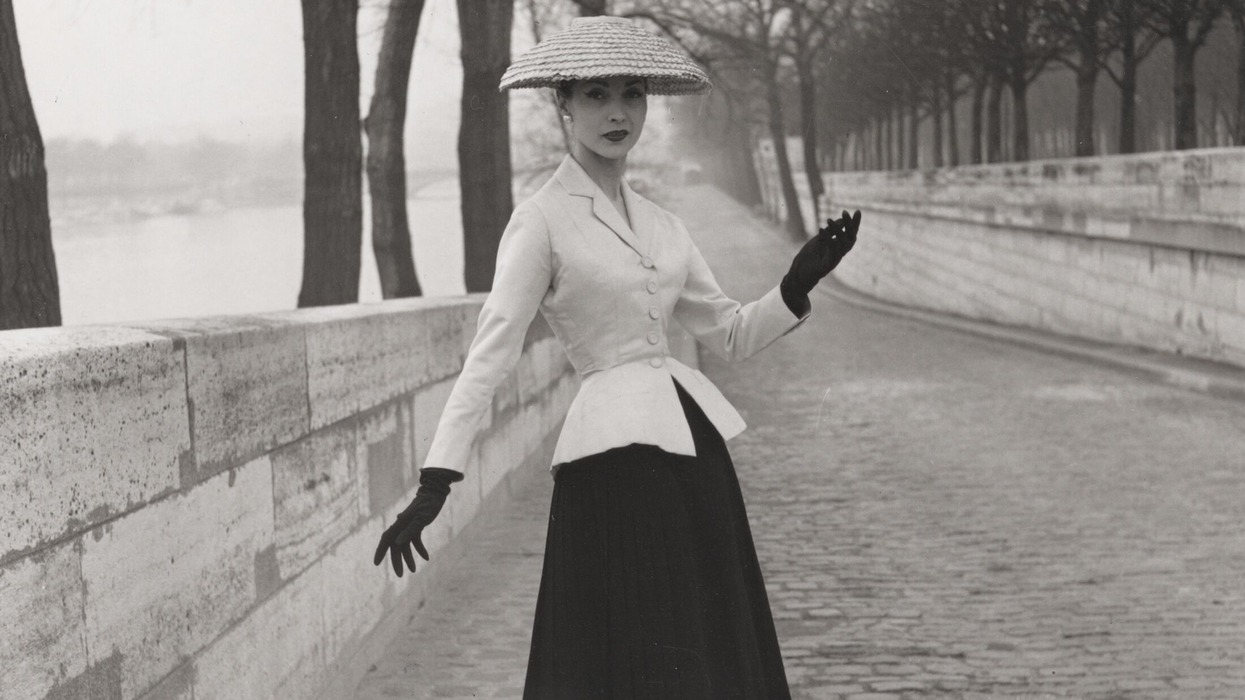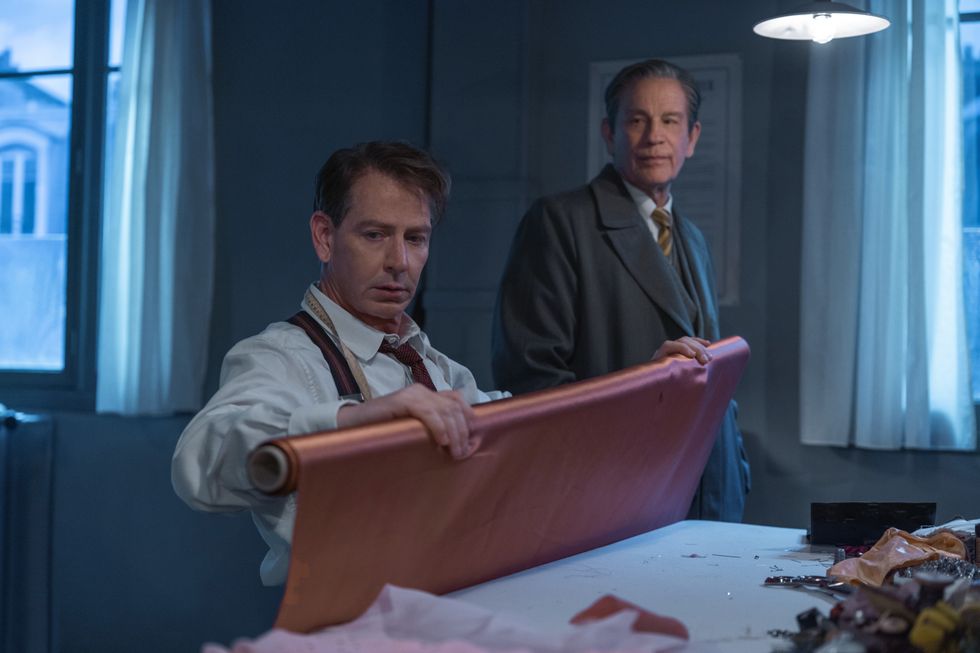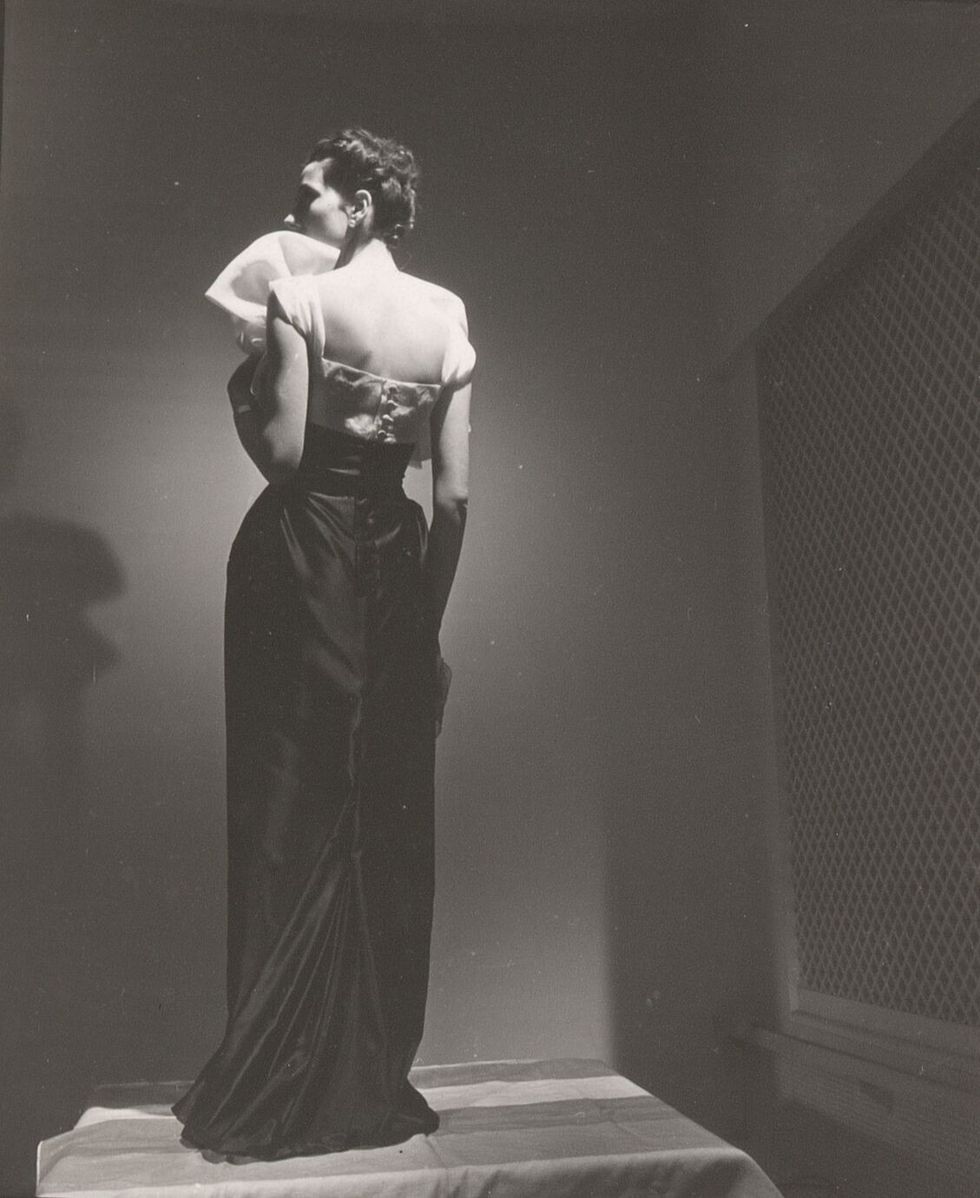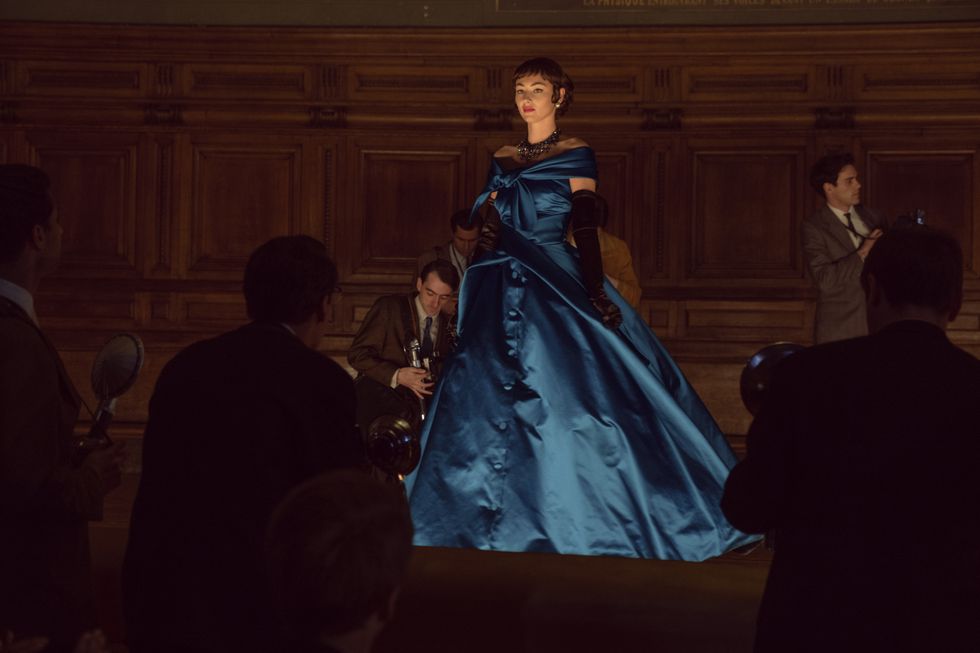After Outfitting the Character of Coco Chanel, Costume Designer Karen Muller Serreau Could Not Stop Wearing Brooches
The ‘New Look’ Costume Designer takes us behind the scenes.

The New Look, debuting on Apple TV+ on February 14th, details the lives of Christian Dior played by Ben Mendelsohn, Coco Chanel played by Juliette Binoche, and their fashion peers both within the industry and outside of it throughout the 1940s and 50s. Zooming out, it catalogs the fashion industry as it braces itself against World War II and its subsequent reinvention, culminating, of course, in Christian Dior’s famous ‘New Look.’ As one could only assume, this matrix entails a paradoxical costume requirement. There are soldiers’ uniforms, pedestrian garb, and resistance fighters’ disguises. Then there’s fanciful eveningwear, divine couture, and designers’ own dress. Costume designer Karen Muller Serreau felt thrilled, daunted, then excited (in that order) to dress them all.

Courtesy of Apple TV+
Unlike a commoner’s ensemble, there’s little room for interpretation in the realm of both uniforms and the famous designers’ creations. “I was not going to take on designing something in the place of Christian Dior,” she muses. For the months of preparation and shooting, Muller Serreau and team ricocheted between the quotidian and the avant-garde. “I'd go through the workshops, and there would be these skimpy little brown, gray, dark, sad things for extras that we were dressing,” she says. “Then, I would turn around to see some beautiful creative evening wear that we were building with rich fabrics.” After burying themselves in the drudgery of these simulated wartimes, they were able to truly feel, in effect, the real brilliance of Dior’s ‘New Look.’ Ahead, Muller Serreau walks us through her creative process, the elements of dressing fashion icons, and how she began emulating one of the characters in her own manner of dress.

Courtesy of Apple TV+
Coming from a fashion perspective, it seems so daunting a task to dress icons like Coco Chanel and Christian Dior. How did you feel when you started on this project?
“I'd use the word thrilled. Then, I'd say I was completely daunted. Then, I was very excited. I think that probably describes how I felt, to begin with, but it's incredible to have a project like this with so much going on in it and costume-wise so amazing things with the characters and the fashion shows and then everything else that goes on.”
Once you got the job, where did you begin? What did this, I'm sure, immense research process look like?
“Yes, it was. I got every book and picture I could find on this period, fashion, non-fashion, and even everyday fashion. The first thing I did was read the script and put images to each scene that I was reading. I did that to create the atmosphere that we were looking for. Then the process was about documenting each character and giving them clothes and colors to work on. Then, color-coding scenes. For the actors, I did storyboards with the pictures of the real people and then the ideas of things that I thought would work, sourcing clothes and accessories for them. But it was an ongoing process all the time. We were learning non-stop, non-stop, reading and looking up things.
“Then I went to Dior to learn about their heritage. I got a lot of information about the fashion shows they were doing. I also read things about Dior's family history so I could get more of an insight into him. But I spent a lot of time just looking at pictures of each character because I think just from looking at people, you learn more and more. I read things about Dior like his love of wearing suits made in England, and he also liked Italian suits. Then I looked at him, and I thought, ‘Actually, he looks really French.’ So we were finding the mixture of the English, the Italian to become French. Things like that would pop out when you look through their history.”

Christian Dior Robe Vogue
Collection Dior Héritage, Paris, Droits Réservés

Christian Dior Robe Vogue
Collection Dior Héritage, Paris, Droits Réservés
In a project like this, is the goal 100% historical accuracy, or is there any room for interpretation?
“Certain things had to be absolutely precise, like the fashion shows. We recreated the exact dresses for the fashion shows. I was not going to take on designing something in the place of Christian Dior. The only other thing that had to be absolutely right to me was military, just because that's something your audiences always pick up on because it's so coded.
“Otherwise, the rest comes through inspiration for each character, which means quite a lot of learning about each one, so you've got a reason why you've chosen what they're wearing. There was not much photo documentation of Chanel during that period, so we relied on photos from before and after. I was also inspired by who she was and what she was creating. On the other hand, Catherine Dior wanted to look like somebody who could hide in the midst of everybody as a resistance worker. As she enters the camps, we only have pictures of other people who have been in camps, so that was what we used for inspiration. But definitely, the fashion shows had to be 100% historically correct to me, but there’s flexibility with everyone else.”
This project really encompasses so many elements as a costume designer–you're doing military, you're doing fashion, you're doing historical, you're doing the quotidian, you're doing camps–was that challenging or exciting to flex all of these different muscles?
“For me, it was fantastic. I'd go through the workshops, and there would be these skimpy little brown, gray, dark, sad things for extras that we were dressing. Then, I would turn around to see some beautiful creative evening wear that we were building with rich fabrics. We worked with extremes all the time. I do think that, when we got to the end of shooting and we got to the New Look, we felt that we'd been through all these war scenes and we'd been through all this gray and this heavy dark period of time. It’s almost like we lived what people were living when the New Look came out, which was this feeling of a happy future ahead of you. It was extraordinary.--I think we really felt it all get much brighter.”

Courtesy of Apple TV+
That's so fascinating. Well, I'm personally always fascinated with designers and how they dress in contrast to what they create. So obviously, you worked with quite a handful, but specifically with Coco Chanel and Christian Dior, what did you learn about how they engaged with their own creations on different levels and how they express themselves personally?
“Well, they had opposite visions of fashion, so I wanted to accentuate that. Coco Chanel would wear more masculine clothes, and she created this comfortable look for women and got rid of corsets. I wanted to give her that feeling but keep her very stylish. She had a casual chic to her. He was a symbol of French elegance and femininity. I think he was probably extremely elegant in the way he dressed–quite the conformist most of the time. Chanel had high-waisted trousers and things that were more of a masculine feel.”
What did you learn about these two people by studying how they got dressed, and looking at all these photos?
“I think we learned a lot about, not so much the clothes they wore, but who they were and their ways of surviving. This series is very much about how the fashion industry survived the war years, and mainly Dior, his early career, and how he uses art as a means of survival. I think Coco Chanel was a woman on her own in a man's world. It was her way of survival, too.”
You worked with Dior a lot, the house, but where were you sourcing materials? Were you redesigning and recreating pieces, or were you actually trying to source old vintage pieces for the characters to wear?
“For the fashion shows, we actually recreated it. For the men's outfits, I went to the north of England and got the heaviest weight of men's fabric I could because materials are so much lighter now and more comfortable than they were back then. There are places in the north of England and London that still make vintage-weight cloth.
“For the womenswear, there were certain items where I had to make several versions of each one. We just searched for the cloth that resembled the fabric at that time. Sometimes I over-dyed it, but we did a lot of material sourcing. I had a fantastic couple of girls that were non-stop sourcing cloth. For each character, I had an idea of what I wanted. We found some vintage shirting, and other bits and pieces that we used. We had to make a couple of the evening wear dresses that weren't in the fashion show. We had one of them that was actually embroidered in India.”
Looking at these brands that still exist today, I don't know how much you try and stay up to date with the current fashion industry, but was it interesting to look at how these brands originated and then see what they're debuting now?
“Oh yeah, completely. Well, what I found astounding is, looking at Dior's next collection, it very much resembles the original New Look. Several other directors, other places I've looked, there's definitely still an influence of the New Look still around. The long skirts and cinched waists are coming back.”

Courtesy of Apple TV+
It's fascinating that great design can persist through so much.
“Coco Chanel said something like, ‘Fashion comes and goes, but style lasts forever.’ If you've got a good style, I think it goes on and on and on.”
I always wonder with costume designers, do you find that working in all of these spaces, did any of what you were consuming for mood boards and everything leak into how you get dressed?
“Yes. I think probably. A lot of my dresses are fairly uniform-like. Actually, I've always worn brooches occasionally, but since I started putting on brooches on Coco Chanel every day, I’ve been wearing one every day, as well. It's funny. Someone used to say, ‘Oh, you've got your Coco Chanel look on.’”
I'm personally fascinated with this concept of a uniform, whether that be a military uniform or a cultivated uniform Christian wears a very similar thing every day), even the resistance fighters end up cultivating their own uniform as well. Were you thinking about this at all when you were assigning all these characters?
“Absolutely. I look at a film set, and everybody looks like technicians on a film set. I think groups of people have particular looks. There's definitely something that a resistance person would wear, and there's definitely things that they wouldn't. I always thought about that while doing mood boards for each scene. You get a feel of the different ways people dress at different moments for different periods of their lives. I find that fascinating. I find the whole social side of dressing extremely fascinating.”